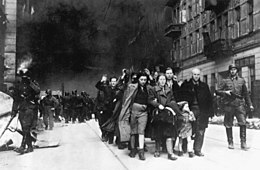
Back Εξεγέρσεις των γκέτο Greek Levantamientos en los guetos judíos Spanish خیزشهای گتو Persian Gheton kansannousu Finnish Soulèvements de ghettos durant la Seconde Guerre mondiale French מרידות בגטאות HE Pemberontakan ghetto ID Rivolte dei ghetti Italian Восстания в еврейских гетто Russian Повстання у єврейських гето Ukrainian
| Ghetto uprisings | |
|---|---|
  Top: members of the United Partisan Organization (FPO) in the Vilna Ghetto, one of the first armed resistance organizations established in the Nazi ghettos during World War II. Bottom: captured Jews during Warsaw Ghetto Uprising led by the Germans for deportation to death camps. Picture taken at Nowolipie street, near the intersection with Smocza | |
| Location | German-occupied Europe |
| Date | 1941–43, World War II |
| Incident type | Armed revolt |
The ghetto uprisings during World War II were a series of armed revolts against the regime of Nazi Germany between 1941 and 1943 in the newly established Jewish ghettos across Nazi-occupied Europe. Following the German and Soviet invasion of Poland in September 1939, Polish Jews were targeted from the outset. Within months inside occupied Poland, the Germans created hundreds of ghettos in which they forced the Jews to live. The new ghettos were part of the German official policy of removing Jews from public life with the aim of economic exploitation.[1] The combination of excess numbers of inmates, unsanitary conditions and lack of food resulted in a high death rate among them.[2] In most cities the Jewish underground resistance movements developed almost instantly, although ghettoization had severely limited their access to resources.[3]
The ghetto fighters took up arms during the most deadly phase of the Holocaust known as Operation Reinhard (launched in 1942), against the Nazi plans to deport all prisoners – men, women and children – to camps, with the aim of their mass extermination.[3]
- ^ Wolf Gruner (2006), Jewish Forced Labor Under the Nazis: Economic Needs and Racial Aims, 1938-1944, Cambridge University Press, pp. 249–250, ISBN 0521838754,
By the end of 1940, the forced-labor program in the General Government had registered over 700,000 Jewish men and women who were working for the German economy in ghetto businesses and as labor for projects outside the ghetto; there would be more.
- ^ Marek Edelman. "The Ghetto Fights". The Warsaw Ghetto: The 45th Anniversary of the Uprising. Literature of the Holocaust, at the University of Pennsylvania. Retrieved 2 October 2013.
- ^ a b "Resistance in Ghettos". Jewish Uprisings in Ghettos and Camps, 1941–1944. Holocaust Encyclopedia. June 10, 2013. Retrieved 9 January 2014.